Please help the NWS spread these important safety messages on social media! Everyone is welcome to use the text and images provided below to help the NWS build a Weather-Ready Nation.
Prepare
Facebook
A Flood WATCH means Be Prepared.
A Flood WARNING means Take Action!
weather.gov/safety/flood-watch-warning
X
A Flood WATCH means Be Prepared.
A Flood WARNING means Take Action!
weather.gov/safety/flood-watch-warning #WeatherReady

Facebook
Flooding can occur during any time of the year, so it’s always best to be prepared! To learn more about flooding and how you can prepare before it happens, visit weather.gov/safety/flood
X
Flooding can occur during any time of the year, so it’s always best to be prepared! To learn more about flooding and how you can prepare before it happens, visit weather.gov/safety/flood #WeatherReady

Facebook
It's important to know what kind of flooding you can expect in your area so that you know how to prepare. Visit weather.gov/safety/flood-map to find out what kind of flooding could impact your home!
X
Know what kind of flooding you can expect in your area. weather.gov/safety/flood-map #WeatherReady

Facebook
Debris flows often happen in areas where excessive rain causes soil to become so saturated it turns into very runny mud. The mud then races downhill, picking up debris such as fallen branches, tree trunks, and rocks as it goes. Debris flows can bury homes under a pile of mud and debris. Know the risks of the area where you live so you can prepare your family and home before heavy rains threaten your area. weather.gov/safety/flood-hazards photo:FEMA
X
Debris flows can bury homes under a pile of mud and debris. Learn more weather.gov/safety/flood-hazards (photo: @fema) #WeatherReady
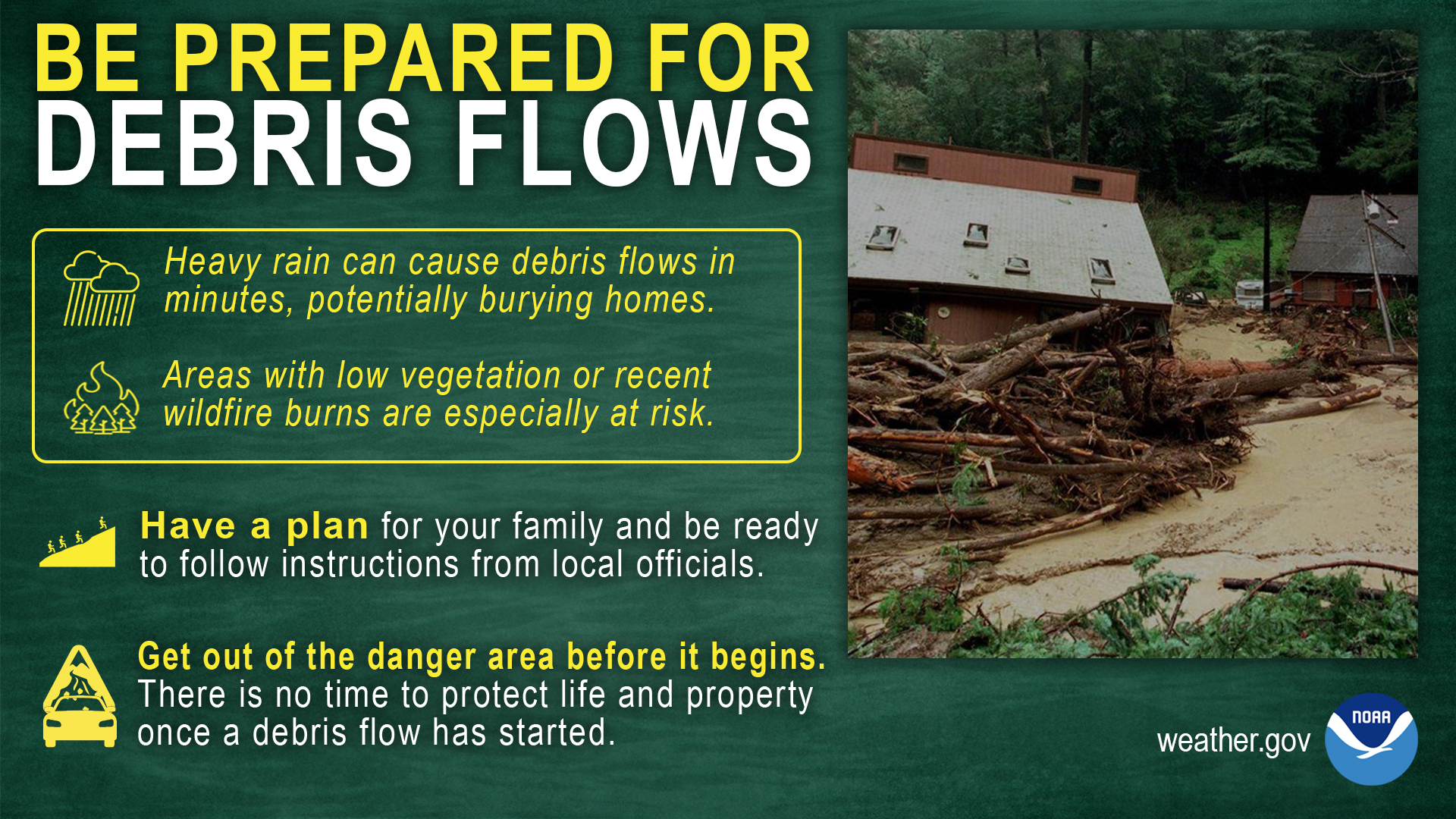
Facebook
Burn scars from wildfires increase the risk of debris flows, which can destroy homes in their paths. Be aware of your surroundings and stay Weather-Ready by having multiple ways to receive weather alerts. weather.gov/safety/flood
X
Burn scars from wildfires increase the risk of debris flows, which can destroy homes in their paths. Be aware of your surroundings and stay #WeatherReady by having multiple ways to receive weather alerts. weather.gov/safety/flood

Facebook
If coastal flooding is expected, be prepared. Elevate your belongings off the ground, move your car to higher ground, and have an evacuation plan.
weather.gov/safety/flood
X
If coastal flooding is expected, be prepared. Elevate your belongings off the ground, move your car to higher ground, and have an evacuation plan. #WeatherReady
weather.gov/safety/flood

Facebook
Whether you’re on the road or camping, will you be ready for sudden flash flooding? Make sure to enable Wireless Emergency Alerts on your phone. If flooding occurs while you’re outdoors, immediately get to higher ground, and NEVER enter flood waters in a vehicle or on foot. weather.gov/safety/flood
X
Will you be ready for sudden flash floods? Stay #WeatherReady by enabling weather alerts on your phone. If flooding occurs while you’re outdoors, immediately get to higher ground, and NEVER enter flood waters in a vehicle or on foot. weather.gov/safety/flood #WeatherReady

Facebook
During a flood, water levels and the rate at which the water is flowing can quickly change. Get to higher ground. Do not drive or walk into water. It only takes 6 inches of water to knock you off your feet. Stay informed by monitoring local radio and television for updates. weather.gov/safety/flood
X
During a flood, water levels and the rate at which the water is flowing can quickly change. Get to higher ground. Do not drive or walk into water. It only takes 6 inches of water to knock you off your feet. weather.gov/safety/flood #WeatherReady
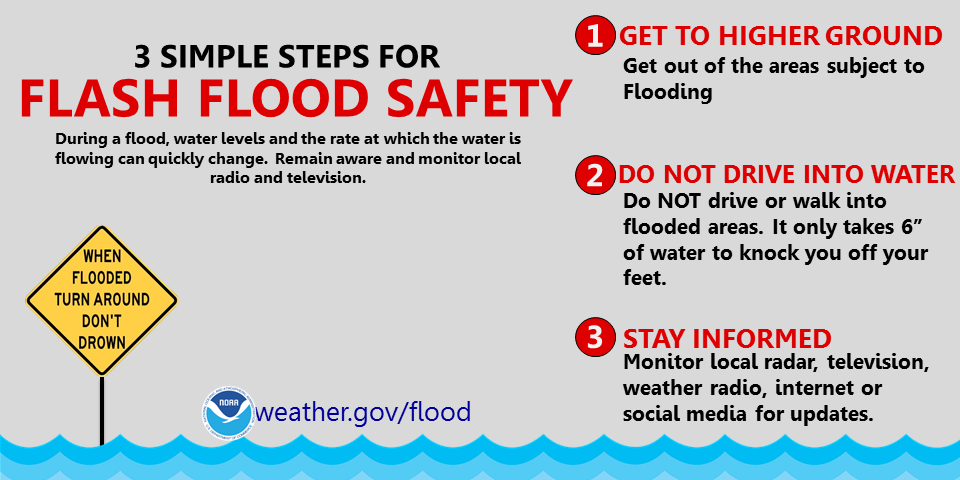
Facebook
During a flood, water levels and the rate at which water is flowing can quickly change. You are safest staying indoors, or seeking higher ground if shelter isn’t available. If you’re stuck outside when a flash flood occurs, do not attempt to cross flood waters by vehicle or on foot.
Learn more about flood safety at weather.gov/safety/flood
X
During a flood, water levels and the rate at which water is flowing can quickly change. You are safest staying indoors, or seeking higher ground if shelter isn’t available. Never cross flood waters by vehicle or on foot. weather.gov/safety/flood #WeatherReady

Facebook
Flood events can devastate communities. Help yours be prepared and safe.
Connect with your neighbors and discuss local flood risks and planning needs.
If flooding is expected, help others elevate and protect their belongings.
After the storm, check on your neighbors and keep others out of floodwater.
weather.gov/safety/flood
X
Flood events can devastate communities. Help yours prepare beforehand and recover after. weather.gov/safety/flood #WeatherReady
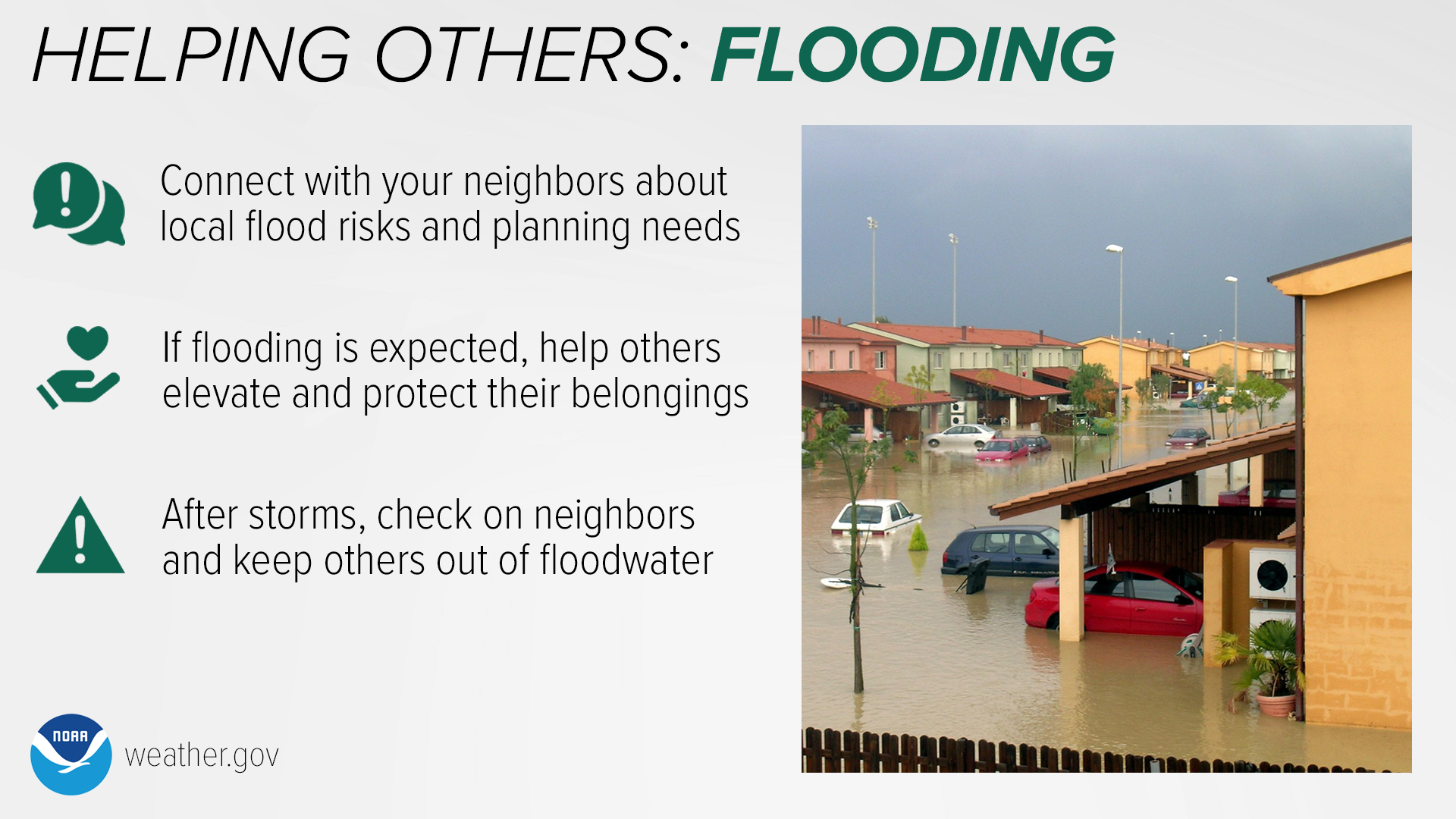
Turn Around Don’t Drown
Facebook
More than 50% of all flood fatalities are vehicle-related. You never know how deep the water is or if the road has been washed away or compromised beneath the water. Don’t risk driving into floodwaters. Turn Around, Don’t Drown!
weather.gov/safety/flood-turn-around-dont-drown
X
More than 50% of all flood fatalities are vehicle-related. You never know how deep the water is or if the road has been washed away or compromised beneath the water. Don’t risk driving into floodwaters. Turn Around, Don’t Drown!
weather.gov/safety/flood-turn-around-dont-drown #WeatherReady

Facebook
Play in the pool, not in floodwaters! Floodwaters can contain dangerous chemicals and objects that could harm you or make you sick. noaa.gov/resource-collections/watersheds-flooding-pollution
X
Play in the pool, not in floodwaters! Floodwaters can contain dangerous chemicals and objects that could harm you or make you sick. noaa.gov/resource-collections/watersheds-flooding-pollution #WeatherReady

Facebook
When you drive into floodwaters, you’re not only putting your own life at risk, but also the lives of your rescuers. It’s far better to be late and remain safe than to take a risk and possibly lose your life. Turn Around, Don’t Drown! weather.gov/safety/flood
X
You are putting your rescuers’ lives at risk when you drive into floodwaters. weather.gov/safety/flood #WeatherReady

Facebook
NEVER drive around barricades into floodwaters! More than 50% of all flood fatalities are vehicle-related. It takes only 12 inches of fast-moving water to carry off a small car and 18 inches of water to sweep a larger vehicle away. Turn Around, Don’t Drown! weather.gov/safety/flood-turn-around-dont-drown
X
NEVER drive around barricades into floodwaters! Most flood fatalities are vehicle-related. It takes only 12 inches of fast-moving water to carry off a small car and 18 inches of water to sweep a larger vehicle away. Turn Around, Don’t Drown! weather.gov/safety/flood-turn-around-dont-drown

Facebook
Driving into floodwaters could be the last decision you ever make. Turn Around Don’t Drown! https://youtu.be/eI6mIlHKrVY
X
Driving into floodwaters could be the last decision you ever make. Turn Around Don’t Drown! https://youtu.be/eI6mIlHKrVY #WeatherReady
Facebook
Most flood fatalities occur in vehicles, and it only takes 12 inches of water to sweep a car away. Sometimes, the difference between life and death is small decisions. During a flood, small decisions like turning around and not driving through a flooded roadway, not driving around barricades, and delaying travel until conditions improve, can make a big impact on whether you keep your car...or even your life. Turn Around, Don’t Drown. weather.gov/safety/flood
X
Most flood fatalities occur in vehicles, and it only takes 12 inches of water to sweep a car away. Sometimes, the difference between life and death is small decisions. weather.gov/safety/flood #WeatherReady

Facebook
What does being Weather-Ready look like? When it comes to flood safety, it means knowing to never drive around barricades or through flooded roads, which are the cause of most flood fatalities. Learn more flood safety tips at weather.gov/safety/flood
X
What does being #WeatherReady look like? When it comes to flood safety, it means knowing to never drive around barricades or through flooded roads, which are the cause of most flood fatalities. Learn more flood safety tips at weather.gov/safety/flood

Facebook
"I would have surely lost the vehicle and maybe our lives...just saying 'Turn Around Don't Drown' saved life and property."
You never know if the road is even below that muddy water anymore. weather.gov/safety/flood-turn-around-dont-drown
X
"I would have surely lost the vehicle and maybe our lives...just saying 'Turn Around Don't Drown' saved life and property."
You never know if the road is even below that muddy water anymore. weather.gov/safety/flood-turn-around-dont-drown #WeatherReady

Facebook
We apologize in advance for this jingle getting stuck in your head, but we’d do anything to help you remember to Turn Around, Don’t Drown. weather.gov/flood
X
We apologize in advance for this jingle getting stuck in your head, but we’d do anything to help you remember to #TurnAroundDontDrown weather.gov/flood #WeatherReady
Facebook
Don’t underestimate the power of water. It only takes 6 inches of fast-moving water to knock over and carry away an adult, and 12 inches to carry away a small car. Turn Around Don’t Drown! weather.gov/safety/flood-turn-around-dont-drown
X
Don’t underestimate the power of water. It only takes 6 inches of fast-moving water to knock over and carry away an adult, and 12 inches to carry away a small car. Turn Around Don’t Drown! weather.gov/safety/flood-turn-around-dont-drown #WeatherReady

Facebook
NEVER drive or walk into floodwaters. It is impossible to know how deep the water is just by looking at it. Turn Around Don’t Drown! weather.gov/safety/flood-turn-around-dont-drown
X
NEVER drive or walk into floodwaters. It is impossible to know how deep the water is just by looking at it. Turn Around Don’t Drown! weather.gov/safety/flood-turn-around-dont-drown #WeatherReady
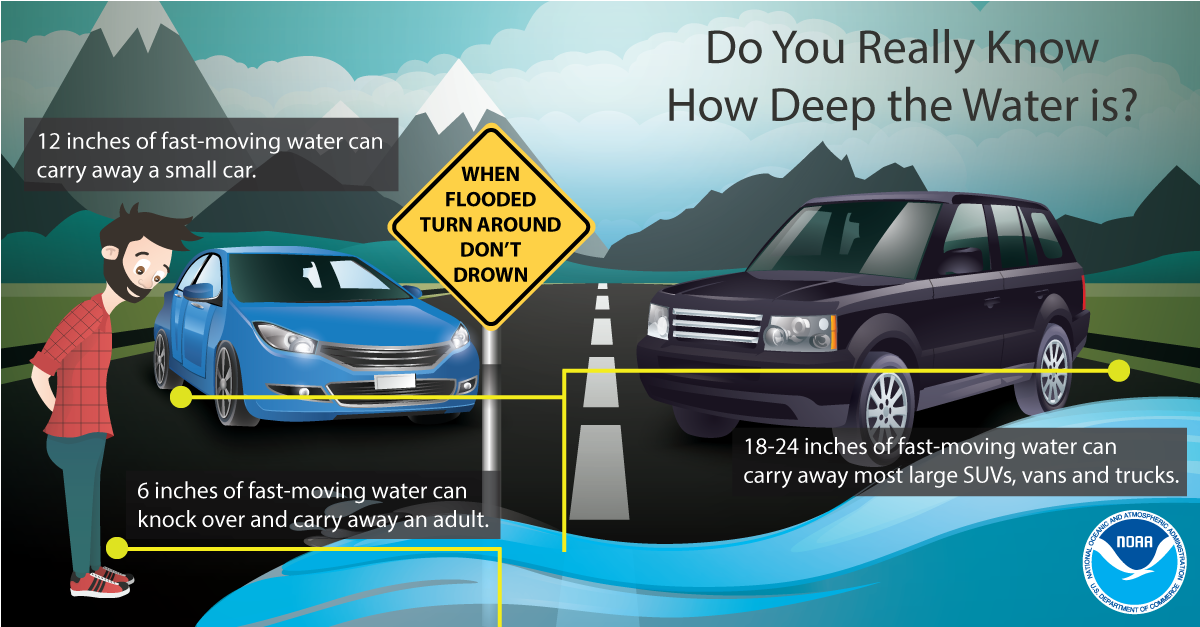
Science
Facebook
Ice jams are common during the winter and spring along rivers, streams, and creeks in the higher latitudes of the continental U.S. as well as in Alaska. Once formed, water can rise VERY quickly. Stay Weather-Ready and never cross flooded roads.
weather.gov/safety/flood-hazards
X
Ice jams are common during the winter and spring along rivers, streams, and creeks in the higher latitudes of the continental U.S. as well as in Alaska. Once formed, water can rise VERY quickly. Stay #WeatherReady and never cross flooded roads.
weather.gov/safety/flood-hazards

Facebook
When normally dry soil becomes overly saturated, it can reach a point where it turns to a liquid state and flows downhill. Learn all about the science of debris flows in the infographic below, and visit noaa.gov/jetstream/thunderstorms/flood for more about floods.
X
Learn all about the science of debris flows, and visit noaa.gov/jetstream/thunderstorms/flood for more about floods. #WeatherReady
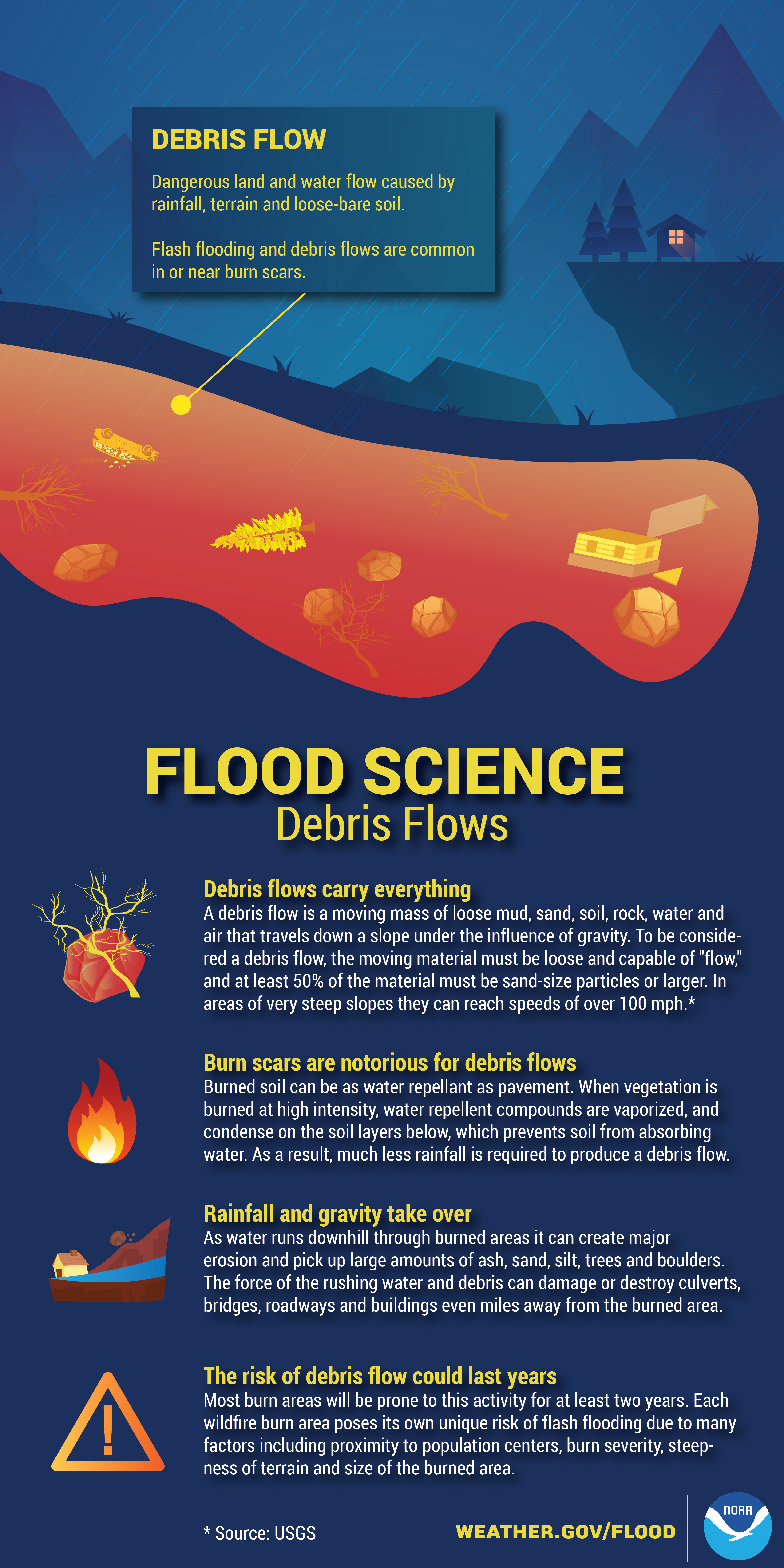
Facebook
The term 500-year flood doesn’t necessarily mean that it’s only going to happen once every 500 years– it’s actually a reference to the probability of occurrence. youtu.be/eQFyaXDH42U
X
The term 500-year flood doesn’t necessarily mean that it’s only going to happen once every 500 years– it’s actually a reference to the probability of occurrence. youtu.be/eQFyaXDH42U #WeatherReady
Facebook
Water is essential for life on Earth – but in large enough quantities, the very substance we drink and use to grow crops can destroy homes, businesses, and cause fatalities. Learn all about the science of river flooding in the infographic below, and visit weather.gov/safety/flood for flood safety tips. #FloodScience
X
Water is essential for life on Earth – but it can also destroy homes, businesses, and cause fatalities. Learn all about the science of river flooding in the infographic below, and visit weather.gov/flood #WeatherReady
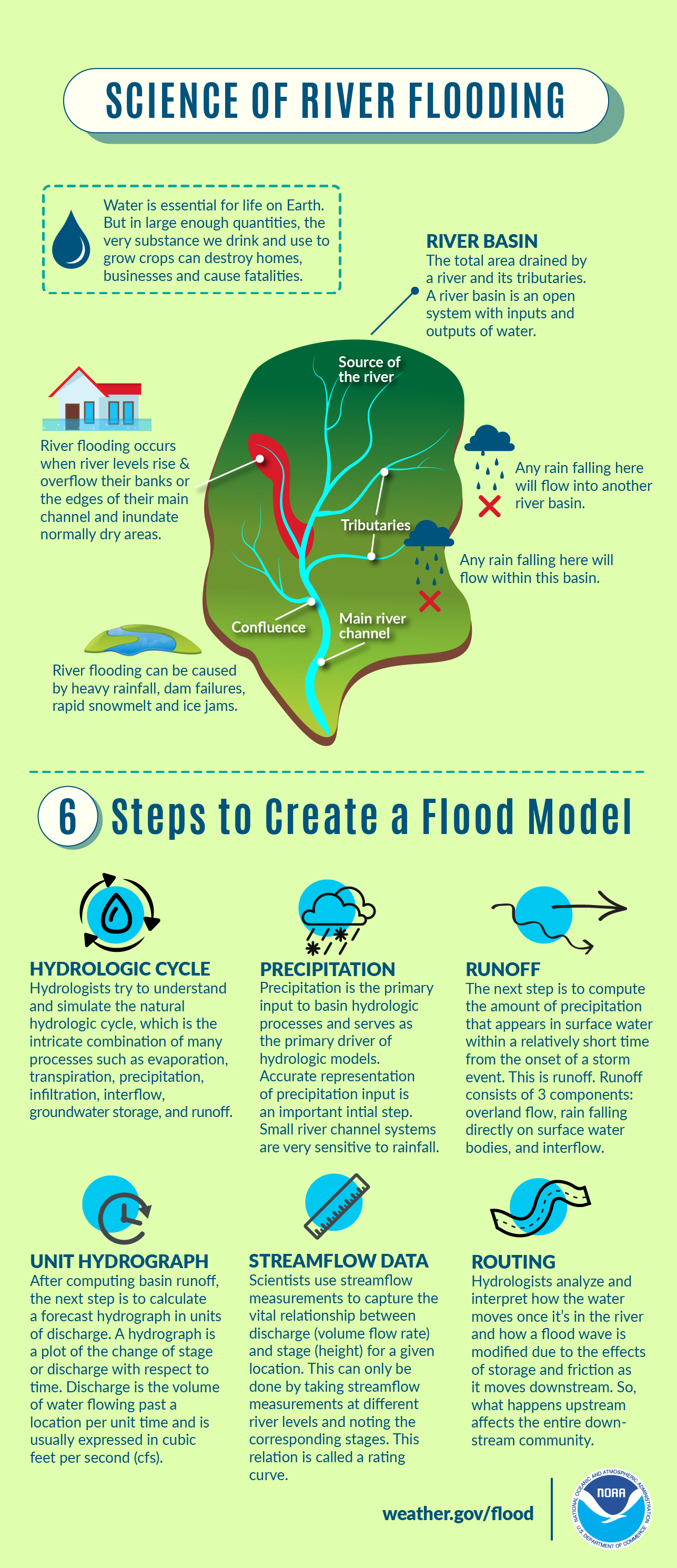
Facebook
Even without rain or snowmelt, floods can happen along any rivers, creeks, and streams. This is because of something called streamflow routing, which occurs when water volume in a river moves from upstream to downstream. Learn more about flood science at weather.gov/jetstream/flood.
X
Even without rain or snowmelt, floods can happen along any rivers, creeks, and streams. This is because of something called streamflow routing, which occurs when water volume in a river moves from upstream to downstream. Learn more about flood science at weather.gov/jetstream/flood.
